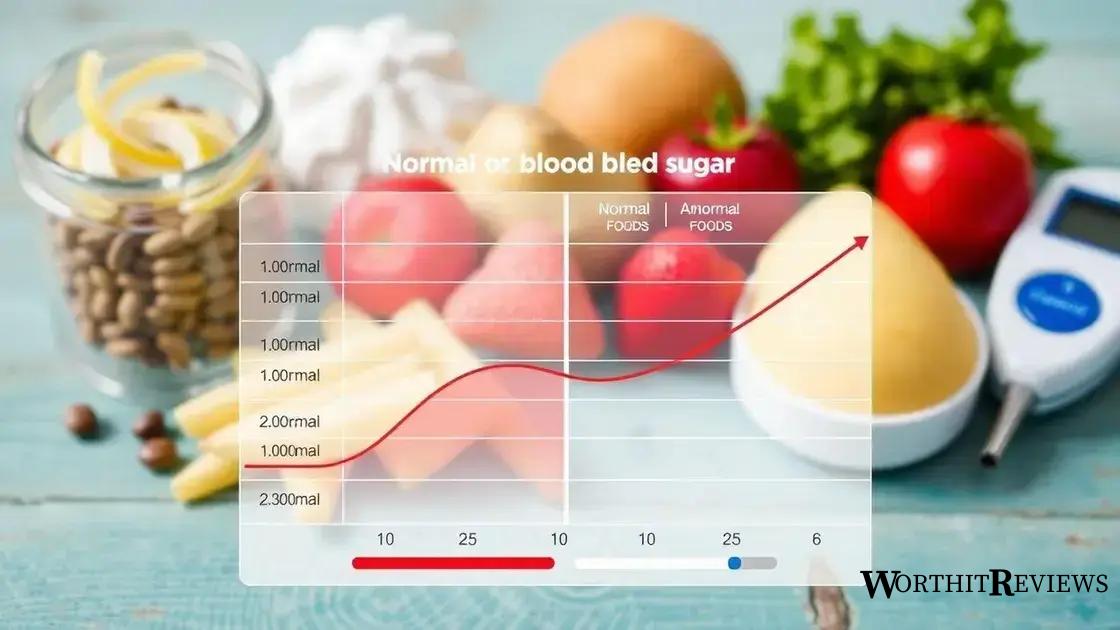Diabetes management requires monitoring blood sugar levels, recognizing symptoms of imbalances, following a healthy diet, engaging in regular exercise, and adhering to prescribed medications to maintain optimal control and prevent complications.
Diabetes 2 blood sugar levels can feel like a puzzling topic, right? Staying informed is crucial for your health. Let’s dig into what these levels mean and how to manage them well.
What are Diabetes 2 blood sugar levels?
Diabetes 2 blood sugar levels refer to the amount of glucose present in your bloodstream, which is critical for understanding the condition. Blood sugar levels can fluctuate throughout the day, influenced by factors such as meals, physical activity, and stress.
Normal Blood Sugar Levels
For most individuals, a normal fasting blood sugar level is below 100 mg/dL. After eating, levels should be less than 140 mg/dL. These benchmarks can help monitor overall health and detect any issues early on.
High Blood Sugar Levels
When blood sugar levels rise above 130 mg/dL when fasting or above 180 mg/dL after meals, it can indicate poor control of diabetes. This may lead to symptoms like increased thirst, frequent urination, and fatigue, and can cause long-term damage to the body.
Importance of Monitoring
Regular monitoring of blood sugar levels is essential for managing diabetes effectively. This helps in making necessary adjustments to diet, exercise, or medication, ensuring better overall health and quality of life.
Understanding normal and abnormal ranges

Understanding blood sugar levels is key in managing diabetes. Normal blood sugar ranges provide a benchmark for maintaining your health. For fasting individuals, normal levels are generally between 70 and 100 mg/dL. After meals, these levels shouldn’t exceed 140 mg/dL.
What Are Abnormal Ranges?
Blood sugar levels above 130 mg/dL when fasting or 180 mg/dL after eating suggest that blood sugar is too high. This can happen due to a variety of factors, including diet, stress, and insufficient medication.
Consequences of Abnormal Levels
High blood sugar, known as hyperglycemia, can lead to serious complications over time. It may cause symptoms like increased thirst, frequent urination, and fatigue. If left untreated, it can result in long-term complications such as nerve damage and kidney problems.
Why Monitoring Is Essential
Frequent monitoring of your blood sugar levels is crucial to ensure they remain within the normal range. It provides insights into how foods, exercise, and medications affect your levels and helps you make informed decisions for your health.
Consequences of high blood sugar levels
High blood sugar levels can have serious impacts on your overall health. When glucose remains in the bloodstream for extended periods, it can lead to both short-term and long-term complications.
Short-Term Consequences
Short-term effects of high blood sugar, or hyperglycemia, may include increased thirst and hunger, frequent urination, and blurred vision. These symptoms signal that your body is struggling to regulate glucose levels effectively.
Long-Term Complications
If high blood sugar is not managed over time, it can result in severe complications. These include cardiovascular diseases, nerve damage, kidney damage, and eye problems such as diabetic retinopathy, which can lead to blindness.
Effect on Mental Health
Besides physical health, high blood sugar can also impact your mental well-being. People with consistently high levels may experience increased anxiety or depression. Understanding and managing your blood sugar can improve your overall mood and quality of life.
Importance of Management
Effective management of blood sugar levels through diet, exercise, and medication is critical. Regular monitoring allows early detection of high levels and supports timely action to prevent complications.
How to monitor your blood sugar effectively

Monitoring your blood sugar levels is essential for managing diabetes. Regular checks can provide you with important insights into your health. Here are effective methods for monitoring your blood sugar levels.
Use a Blood Glucose Meter
The most common method is using a blood glucose meter. This handheld device allows you to check your blood sugar levels easily. You simply prick your finger, place a drop of blood on a test strip, and insert it into the meter. Results typically appear within seconds.
Continuous Glucose Monitors
Continuous glucose monitors (CGMs) are advanced devices that track your blood sugar levels throughout the day. They use a small sensor placed under your skin to measure glucose levels continuously. This can provide valuable data and help you detect trends in your levels.
Keep a Log
Maintaining a blood sugar log is a great way to track your levels over time. Write down your readings several times a day and note any factors like meals, exercise, or stress that may impact your levels. This can help you identify patterns and make necessary adjustments.
Consult Your Healthcare Provider
Regular check-ins with your healthcare provider are crucial. They can help you understand how to interpret your readings and provide personalized recommendations for managing your diabetes effectively. They may also guide you on how often to monitor your levels based on your individual needs.
Diet tips for managing blood sugar levels
Managing blood sugar levels through your diet can make a big difference in your health. Here are some effective diet tips to help keep your blood sugar stable.
Choose Whole Foods
Focus on whole foods like fruits, vegetables, whole grains, and lean proteins. These foods contain essential nutrients and fiber, which can help regulate blood sugar levels.
Control Portion Sizes
Be mindful of portion sizes. Eating large quantities, even of healthy foods, can lead to spikes in blood sugar. Use smaller plates and measure servings to help keep portions in check.
Limit Sugary Foods
Avoid foods high in sugar and refined carbohydrates, like candies, pastries, and sugary drinks. These foods can cause quick spikes in blood sugar. Instead, opt for healthier snacks like nuts or yogurt.
Include Healthy Fats
Incorporate healthy fats into your diet. Foods like avocados, olive oil, and nuts can slow down the absorption of sugar and help maintain more stable blood sugar levels.
Stay Hydrated
Drink plenty of water throughout the day. Staying hydrated can help your body manage blood sugar levels more effectively. Aim for at least 8 glasses of water daily.
Plan Balanced Meals
Each meal should include a balance of carbohydrates, protein, and healthy fats. This balance can help slow down digestion and promote steady blood sugar levels throughout the day.
The role of exercise in blood sugar control

Exercise plays a crucial role in managing blood sugar levels. Regular physical activity can help your body use insulin more effectively, leading to better control of blood glucose. Here are some important aspects of how exercise impacts blood sugar control.
Improving Insulin Sensitivity
When you exercise, your muscles use glucose for energy, which helps lower blood sugar levels. This can improve your insulin sensitivity, meaning your body can use insulin more efficiently. Over time, this may help stabilize your blood sugar levels.
Types of Exercise
Both aerobic and strength-training exercises are beneficial. Activities like walking, jogging, swimming, and cycling help improve cardiovascular health and lower blood sugar. Strength training can build muscle, which also aids in blood sugar management by utilizing glucose effectively.
Exercise Recommendations
Aim for at least 150 minutes of moderate-intensity exercise each week. This translates to about 30 minutes most days of the week. Always start slowly and gradually increase the intensity and duration of your workouts as you become more fit.
Monitoring Blood Sugar Levels
Check your blood sugar levels before and after exercising. This helps you understand how your body responds to different activities. If you notice significant changes, adjusting your workout routine or food intake may be necessary.
Combining Exercise with a Healthy Diet
For optimal blood sugar control, combine regular exercise with a well-balanced diet. Eating healthy foods alongside staying active can enhance the effects of your workouts and lead to more stable glucose levels.
Medications and treatments for diabetes
Managing diabetes often involves a combination of medications and lifestyle changes. Understanding the different types of treatments available can help you maintain better blood sugar control.
Types of Medications
There are various medications for diabetes, including insulin and oral medications. Insulin is essential for Type 1 diabetes and is sometimes used in Type 2 diabetes. Oral medications work in different ways to lower blood sugar levels, including increasing insulin sensitivity or promoting insulin release.
Injectable Medications
In addition to insulin, there are injectable medications like GLP-1 receptor agonists that help manage blood sugar levels by mimicking hormones that control glucose levels. These medications can also assist in weight loss.
Blood Sugar Monitoring
Alongside medications, regular blood sugar monitoring is crucial. This helps you understand how your medications are affecting your blood sugar levels and allows for necessary adjustments.
Consultation with Healthcare Providers
It’s vital to work closely with your healthcare providers to determine the best treatment plan for your needs. They can help tailor medications based on your individual health profile and offer guidance on how to manage your diabetes effectively.
Lifestyle Modifications
Along with medications, lifestyle changes such as adopting a balanced diet, engaging in regular physical activity, and managing stress are important in achieving optimal blood sugar control. Combining these strategies enhances the effectiveness of your diabetes treatment.
Recognizing symptoms of blood sugar imbalance

Recognizing the symptoms of blood sugar imbalance is crucial for managing diabetes effectively. Blood sugar levels that are too high or too low can cause various symptoms that should not be ignored.
Symptoms of High Blood Sugar
When blood sugar levels are elevated, commonly referred to as hyperglycemia, you may experience symptoms such as:
- Increased thirst and dry mouth
- Frequent urination
- Fatigue and weakness
- Blurred vision
- Headaches
If these symptoms occur, it is essential to check your blood sugar levels and take appropriate action.
Symptoms of Low Blood Sugar
Conversely, low blood sugar, known as hypoglycemia, can also produce several noticeable symptoms:
- Shakiness or trembling
- Rapid heartbeat
- Sudden feelings of hunger
- Dizziness or lightheadedness
- Pale skin and sweating
Hypoglycemia can be dangerous and may require immediate treatment, usually with a quick source of sugar like fruit juice or glucose tablets.
Importance of Awareness
Being aware of these symptoms can lead to prompt treatment, preventing serious complications. Monitor your blood sugar regularly and keep track of how different foods and activities affect your levels.
Consult a Healthcare Provider
If you notice frequent symptoms of blood sugar imbalances, consult your healthcare provider. Together, you can devise a plan that best suits your needs and helps maintain healthy blood sugar levels.
Managing Diabetes Effectively
Managing diabetes is a journey that requires understanding, commitment, and the right strategies. From monitoring blood sugar levels to knowing the symptoms of imbalances, each step is important.
Incorporating healthy eating, regular exercise, and appropriate medications plays a vital role in achieving good control over your blood sugar. Always stay alert to your body’s signals and consult your healthcare provider for personalized guidance.
With the right knowledge and tools, you can lead a healthy and active life while effectively managing diabetes.
